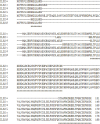1. Choi JD, Bae SY, Hong JW, Azam T, Dinarello CA, Her E, Choi WS, Kim BK, Lee CK, Yoon DY, et al. Identification of the most active interleukin-32 isoform. Immunology. 2009; 126:535–542.



2. Cho KA, Jun YH, Suh JW, Kang JS, Choi HJ, Woo SY.
Orientia tsutsugamushi induced endothelial cell activation via the NOD1-IL-32 pathway. Microb Pathog. 2010; 49:95–104.

3. Calabrese F, Baraldo S, Bazzan E, Lunardi F, Rea F, Maestrelli P, Turato G, Lokar-Oliani K, Papi A, Zuin R, et al. IL-32, a novel proinflammatory cytokine in chronic obstructive pulmonary disease. Am J Respir Crit Care Med. 2008; 178:894–901.


4. Kim SH, Han SY, Azam T, Yoon DY, Dinarello CA. Interleukin-32: a cytokine and inducer of TNFα. Immunity. 2005; 22:131–142.

5. Choi J, Bae S, Hong J, Ryoo S, Jhun H, Hong K, Yoon D, Lee S, Her E, Choi W, et al. Paradoxical effects of constitutive human IL-32γ in transgenic mice during experimental colitis. Proc Natl Acad Sci U S A. 2010; 107:21082–21086.



7. Kwon OC, Kim S, Hong S, Lee CK, Yoo B, Chang EJ, Kim YG. Role of IL-32 gamma on bone metabolism in autoimmune arthritis. Immune Netw. 2018; 18:e20.

8. Lee S, Choi DK, Kwak A, Kim S, Nguyen TT, Gil G, Kim E, Yoo KH, Kim IA, Lee Y, et al. IL-32-induced inflammatory cytokines are selectively suppressed by α1-antitrypsin in mouse bone marrow cells. Immune Netw. 2017; 17:116–120.



9. Cheon S, Lee JH, Park S, Bang SI, Lee WJ, Yoon DY, Yoon SS, Kim T, Min H, Cho BJ, et al. Overexpression of IL-32alpha increases natural killer cell-mediated killing through up-regulation of Fas and UL16-binding protein 2 (ULBP2) expression in human chronic myeloid leukemia cells. J Biol Chem. 2011; 286:12049–12055.



10. Jeong HJ, Oh HA, Lee BJ, Kim HM. Inhibition of IL-32 and TSLP production through the attenuation of caspase-1 activation in an animal model of allergic rhinitis by Naju Jjok (
Polygonum tinctorium). Int J Mol Med. 2014; 33:142–150.


11. Bang BR, Kwon HS, Kim SH, Yoon SY, Choi JD, Hong GH, Park S, Kim TB, Moon HB, Cho YS. Interleukin-32γ suppresses allergic airway inflammation in mouse models of asthma. Am J Respir Cell Mol Biol. 2014; 50:1021–1030.


12. Bae S, Kang D, Hong J, Chung B, Choi J, Jhun H, Hong K, Kim E, Jo S, Lee S, et al. Characterizing antiviral mechanism of interleukin-32 and a circulating soluble isoform in viral infection. Cytokine. 2012; 58:79–86.


13. Jhun H, Choi J, Hong J, Lee S, Kwak A, Kim E, Jo S, Ryoo S, Lim Y, Yoon DY, et al. IL-32γ overexpression accelerates streptozotocin (STZ)-induced type 1 diabetes. Cytokine. 2014; 69:1–5.


14. Kim SJ, Lee S, Kwak A, Kim E, Jo S, Bae S, Lee Y, Ryoo S, Choi J, Kim S. Interleukin-32γ transgenic mice resist LPS-mediated septic shock. J Microbiol Biotechnol. 2014; 24:1133–1142.


15. Jaekal J, Jhun H, Hong J, Park S, Lee J, Yoon D, Lee S, Her E, Yang Y, Rho G, et al. Cloning and characterization of bovine interleukin-32 beta isoform. Vet Immunol Immunopathol. 2010; 137:166–171.


16. Dahl CA, Schall RP, He HL, Cairns JS. Identification of a novel gene expressed in activated natural killer cells and T cells. J Immunol. 1992; 148:597–603.

17. Bai X, Kim SH, Azam T, McGibney MT, Huang H, Dinarello CA, Chan ED. IL-32 is a host protective cytokine against Mycobacterium tuberculosis in differentiated THP-1 human macrophages. J Immunol. 2010; 184:3830–3840.


18. Bai X, Ovrutsky AR, Kartalija M, Chmura K, Kamali A, Honda JR, Oberley-Deegan RE, Dinarello CA, Crapo JD, Chang LY, et al. IL-32 expression in the airway epithelial cells of patients with
Mycobacterium avium complex lung disease. Int Immunol. 2011; 23:679–691.

19. Schenk M, Krutzik SR, Sieling PA, Lee DJ, Teles RM, Ochoa MT, Komisopoulou E, Sarno EN, Rea TH, Graeber TG, et al. NOD2 triggers an interleukin-32-dependent human dendritic cell program in leprosy. Nat Med. 2012; 18:555–563.



20. Semango G, Heinhuis B, Plantinga TS, Blokx WA, Kibiki G, Sonda T, Mavura D, Masenga EJ, Nyindo M, van der Ven AJ, et al. Exploring the role of IL-32 in HIV-related Kaposi sarcoma. Am J Pathol. 2018; 188:196–203.


21. Akuzum B, Kim S, Nguyen TT, Hong J, Lee S, Kim E, Kim J, Choi Y, Jhun H, Lee Y, et al. L1 recombinant proteins of HPV tested for antibody forming using sera of HPV quadrivalent vaccine. Immune Netw. 2018; 18:e19.

22. Bai X, Aerts SL, Verma D, Ordway DJ, Chan ED. Epidemiologic evidence of and potential mechanisms by which second-hand smoke causes predisposition to latent and active tuberculosis. Immune Netw. 2018; 18:e22.









 PDF
PDF Citation
Citation Print
Print



 XML Download
XML Download